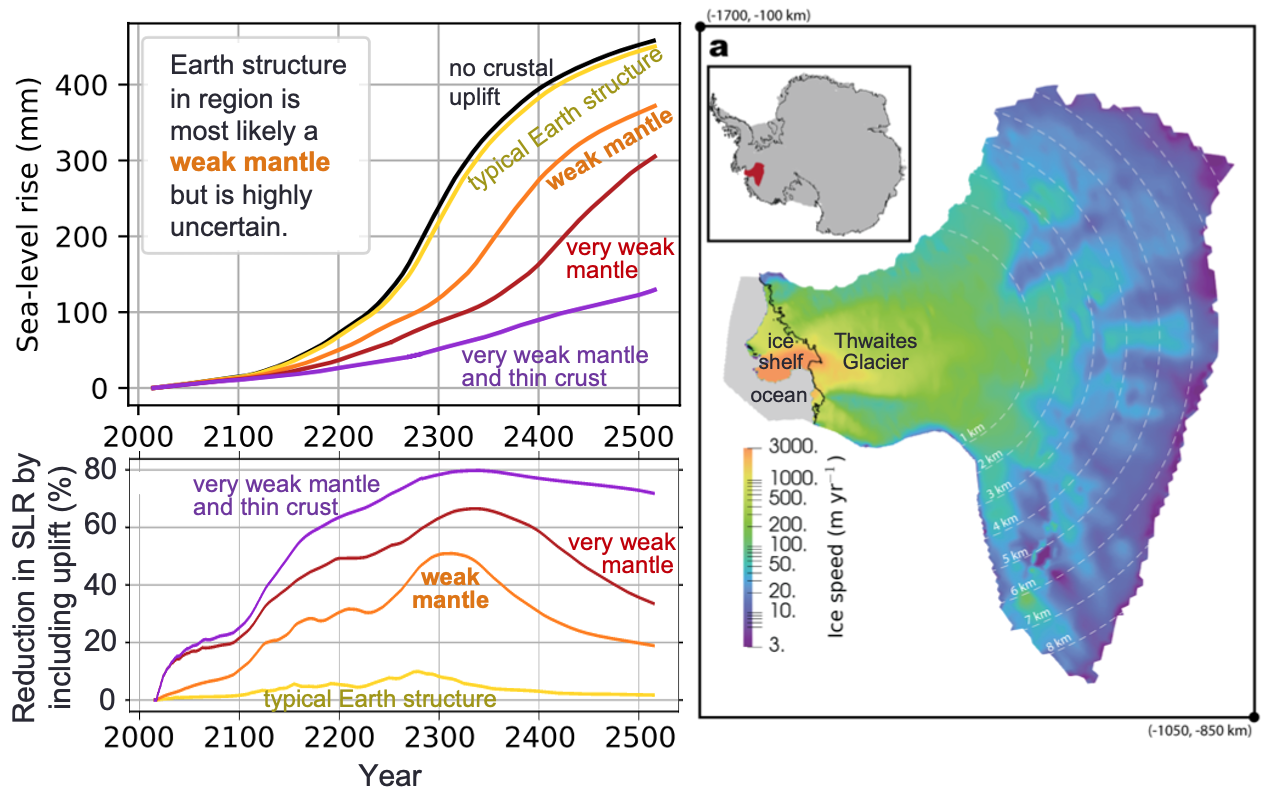Bedrock Uplift to Reduce Thwaites Glacier Retreat
Rapid rebound of the Earth’s crust will slow the loss of glacier ice from West Antarctica.
The Science
Thwaites Glacier, Antarctica, is subject to rapid retreat and could raise sea level by over half a meter. However, it overlies a region of anomalously low mantle viscosity and thin lithosphere, meaning the crust could rebound quickly as the ice thins, slowing further retreat.
The researchers conducted 500-year projections of Thwaites Glacier, Antarctica, including crustal uplift from glacial isostatic adjustment and considering the anomalously weak solid Earth structure in this region. They discovered that rapid uplift from the weak crust and mantle conditions significantly slow glacier retreat and reduce ice mass loss by 20% or more beyond about a century.
The Impact
The results show that crustal uplift is a negative feedback that will substantially slow retreat of Thwaites Glacier on human timescales. This process is typically not included in model projections of the Antarctic Ice Sheet over the next century but should be added.
Summary
The scientists goal was to investigate the effects of glacial isostatic adjustment on glacier mass loss in Thwaites Glacier, Antarctica. They ran 500-year simulations of a coupled higher-order ice-sheet, MALI (Hoffman et al., 2018), and planar glacial isostatic adjustment model, giapy (Kachuck et al., 2020). The researchers considered solid-earth rheologies that included typical-Earth values and likely and extreme values for the region. Then they compared the results using the different rheologies to a control excluding bedrock uplift (Fig. 1). The most likely rheology reduced glacier mass loss by >20% beyond about 100 years. The extreme but possible rheology reduced mass loss by over 70%. The results show that crustal uplift will substantially slow retreat of Thwaites Glacier and this process should be included in Antarctic Ice Sheet projections. Further, the stabilizing effect of crustal uplift substantially declines with stronger climate forcing, indicating the potential societal benefit of this feedback is itself dependent on the greenhouse gas emission pathway chosen by society. More observations are needed to reduce the uncertainty in the rheology and the strength of this negative feedback.
Publication
- Stabilizing effect of bedrock uplift on retreat of Thwaites Glacier, Antarctica, at centennial timescales, Book, Cameron, Matthew J. Hoffman, Samuel B. Kachuck, Trevor R. Hillebrand, Stephen F. Price, Mauro Perego, and Jeremy N. Bassis. 2022. “Stabilizing Effect Of Bedrock Uplift On Retreat Of Thwaites Glacier, Antarctica, At Centennial Timescales”. Earth And Planetary Science Letters 597. Elsevier BV: 117798. doi:10.1016/j.epsl.2022.117798.
Funding
- This work was supported by the Earth System Model Development program area of the Department of Energy, Office of Science, Biological and Environmental Research program.
Contact
- Matthew Hoffman, Los Alamos National Laboratory
This article is a part of the E3SM “Floating Points” Newsletter, to read the full Newsletter check:


![Thwaites Glacier, Antarctica [Felton Davis, Flickr]](https://e3sm.org/wp-content/uploads/2022/11/22-01-02-04-Thwaites-Glacier-_-Felton-Davis-_-Flickr.jpg)

